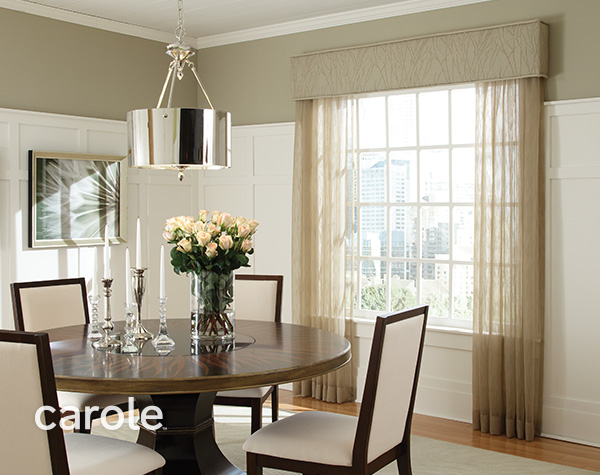
All About Embroidery
February 15, 2022
Selecting Drapery Hardware
June 16, 2022Whether you are designing for yourself or a client, understanding how to choose between traversing drapery or stationary side panels is essential so you make the right choice for the room, the window, and your lifestyle!
First, let's define each of these drapery types.
Stationary Side Panels frame the sides of your windows. They typically use one to two widths fabric and, once installed on hardware, they stay in place. They do NOT close.
Traversing Drapery use more fabric so the draperies can open and close. They cover the entire window when closed.
How do you choose? Several factors go into making this decision.
1. Light Control and Privacy
Panels are decorative, framing the window beautifully. But because they do not close, a blind or shade would need to be added to control light or add privacy. In this case, stationary panels will cover light or privacy gaps that may exist on the sides of the undertreatment.
Traversing draperies close over the window, providing excellent privacy and light control. Different effects can be created based on your choice of drapery lining. A translucent lining will filter the light and cut glare whereas a blackout lining will darken the room.
2. Climate Control
Heat is drawn to cold. Heat can build up during the summer when the sun streams through your windows, and heat escapes in the winter through the glass. If this is a concern, traversing draperies are a better choice for climate control. Because these draperies fully close and you have lining options, heat transfer can be reduced to keep your home cooler in the summer and warmer in the winter.


3. Budget
If your client loves a certain drapery fabric but there are budget concerns, consider side panels. They use less fabric, making them more economical.
If light control or privacy are needed, however, an undertreatment will be required. Remember to add all costs together and then compare to traversing drapery in the same fabric for an accurate estimate.
4. Stackback
Stackback is the amount of space taken up by the fabric on the sides of the window when the draperies are open. Traversing drapery typically stacks to approximately one-third of its full width. For example, drapery that is 99" wide when closed will take up about 33" of space when pulled open.
If you don't have the space to stack the drapery where you want it, then stationary side panels are a great alternative because they remain at the width you specify.
5. Drapery Header Style
There are recommended applications for every drapery header style.
If you use a style that is recommended for stationary side panels as traversing drapery, there are consequences. The header may include pleats or folds that do not stack when the draperies are pulled open. The draperies may require significant hand dressing each time they are repositioned.
The chart below outlines the recommended application for each drapery header style. Following the recommendations will yield the best results. If you decide to use a Stationary style as a traversing drapery, be sure you understand the implications and manage your client's expectations.
Drapery Header Style Recommended Applications
| Stationary Only | Stationary or Traversing | Traversing Only |
| Goblet Pleat | Inverted Pleat | Ripplefold Drapery |
| Natural Pleat | Monarch Pleat | |
| Relaxed Pleat | Olivia Pleat | |
| Tuxedo Pleat | Single Pleat | |
| Grommet Top | Two Finger Pinch Pleat | |
| Hidden Tab Top | Three Finger Pinch Pleat | |
| Plain Top | ||
| Rod Pocket |
6. Additional Considerations
If you're using stationary side panels with a center panel, consider tying them all together with a top treatment. A cornice or valance can add that finishing touch!
Side panels are also an easy way to add height to a room. Panels installed above the window draw the eye to the top of the drapery and elongate the room. This may be easier to do with stationary panels because the additional fabric needed for longer draperies that close may cause traversing drapery to become too heavy for easy repositioning.
Whether you choose traversing drapery or stationary side panels, I'm confident that your design will be beautiful! Use the hashtag #carolefabrics to share your redesigned spaces with us on social media.

Susan Pfingst
National Training Coordinator
With over 35 years in the Home Design Industry, Susan brings her extensive experience in design and sales. Training is her passion and she looks forward to sharing her insight!

